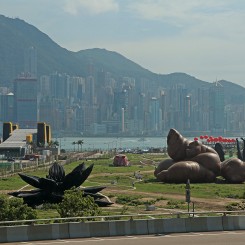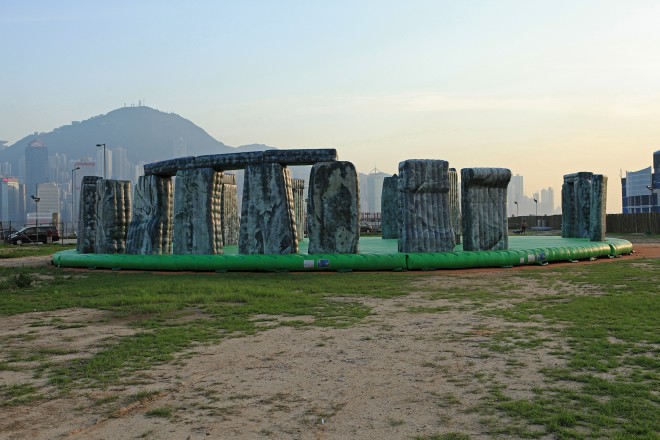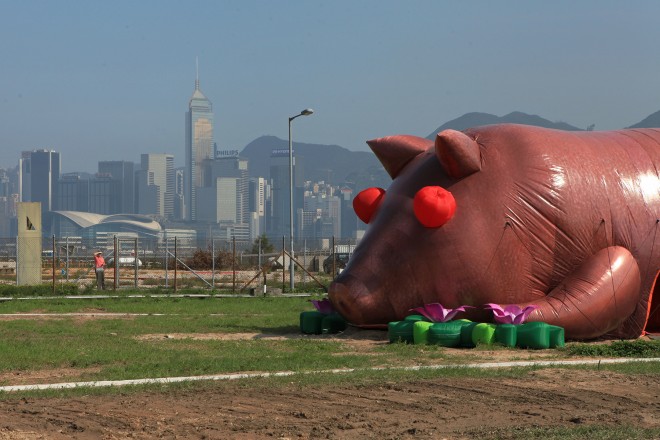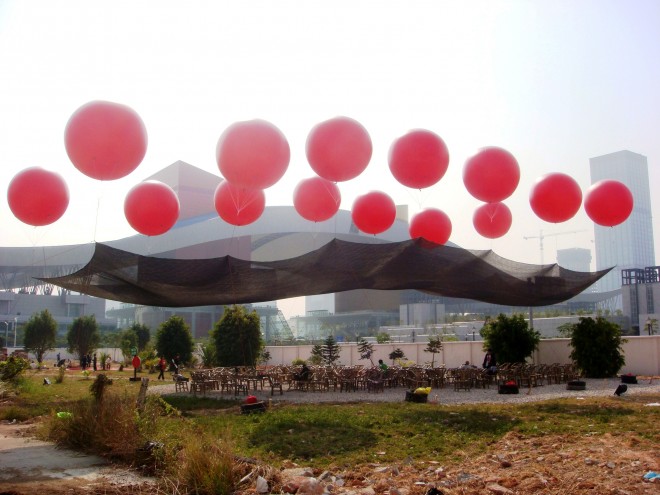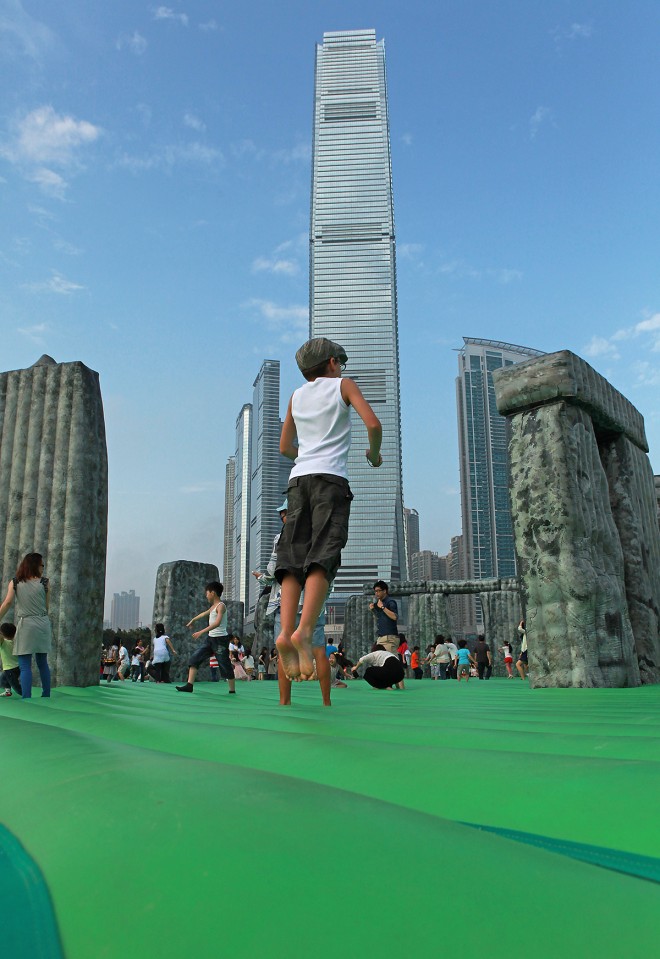M+ (West Kowloon Cultural District, Hong Kong) Apr 25 – June 09, 2013
There is a certain kind of freedom in exhibition practice that comes along with a purity of purpose; the strongest curatorial work often comes not from those with carte blanche and unlimited budgets to develop projects wild beyond the imagination, but rather from those who are acutely aware of and indeed revel in the restrictions of particular cultural contexts. For the nascent curatorial team at M+, Hong Kong’s museum of visual culture in West Kowloon, the salient demand of the moment is the cultivation of an audience for their future institution. There is no doubt that they will produce intellectually impressive and internationally recognized research around their collection and commissions—the better question is, will anyone in Hong Kong care?
Fortunately, all of the early appointments to the M+ curatorial department are figures not only respected for their independent work but also known for a certain public ethos that could be described as a combination of contextual sensitivity and a willingness to commit to early stages of audience development. Take, for instance, the three curators behind the exhibition “Inflation!” currently installed on the construction site that is West Kowloon as the second iteration of Mobile M+: there is Pi Li, one of the first mainland Chinese curators to attempt the formation of a foundation-funded exhibition program in 2005, and who is clearly enjoying the public accountability and transparency of his position in Hong Kong as a breath of fresh air after the Beijing commercial gallery scene; Tobias Berger, who has probably done more than any other single curator in Hong Kong to build up an audience for global contemporary art, beginning with his time at Para/Site Art Space and October Contemporary, the now-defunct fall art festival; and Pauline Yao, recognized for her work with the Beijing neighborhood storefront Arrow Factory in terms of bringing art out of the gallery districts. This is very much a team that understands how to fill a need, and an outdoor exhibition of large-scale inflatable sculptures is indeed a pitch-perfect attempt at drawing a broader audience not only to the physical site of West Kowloon but also to the conceptual space it occupies.
One of the core genre tools often deployed for exhibitions intended to invite public participation is, of course, participatory art. “Inflation!” wisely steers away from anything knotty and relational, instead opting for a more literal form of visitor-work interaction that also makes space for unorthodox relationships between visitors. Jeremy Deller’s Sacrilege (2012), for instance, translates the sacred space of Stonehenge into the language (and function) of a backyard bouncy castle, inviting visitors to take off their shoes and jump on. Indeed, it makes for a pleasant diversion against the backdrop of Victoria Harbour. Surprisingly, local media have seized upon the work as an emblem of Hong Kong’s British heritage—a sure sign of the city’s unique ability to politicize just about everything, much to the delight of its intellectual class.
One of the other unique abilities of the Hong Kong media allows it to keep the city talking about the same thing for days on end—especially if they are gruesome, eerie, cute, or otherwise spectacular. Florentijn Hofman’s giant floating rubber duck, a piece of fluff that is decidedly not part of “Inflation!” but rather a marketing gimmick put on by a neighboring mall, has been an image of constant circulation across social media for the past month, and our local paper of record, the South China Morning Post, has published no fewer than 12 articles covering its arrival in the harbour. It may not look like much, but this too contributes something to the aura of excitement around contemporary art currently being propagated in Hong Kong. And the Mobile M+ exhibition has its share of spectacle: Paul McCarthy’s Complex Pile (titled Complex Shit prior to its arrival on the politer shores of Hong Kong) has similarly been an object of awe across media social and otherwise, and has made an easy target for pundits looking to score points by bashing the cultural pretensions of the Hong Kong left. Such critiques, however, often appear surprisingly muted. What, after all, can anyone say about a pile of shit other than the fact that it looks like a pile of shit?
But perhaps the categorical vitriol levelled against spectacle is unfair, particularly when the exhibition is openly primed to attract attention from an audience beyond the usual art public. After all, the very genre of large-scale inflatable sculpture begs for the artist to play with such expectations. Cao Fei has the rare opportunity to do so as only of only two specially commissioned artists in the project, and her House of Treasures (2013) does so quite successfully. From a distance it appears as a giant inflatable roast suckling pig, functioning as her nod to her own background in Cantonese culture: the roast piglet often appears at opening ceremonies for restaurants, film premiers, and new gallery spaces, so this is both a ritual congratulations for the progress of M+ and a subtle poke at the fact that there is still nothing permanent on the site. Approaching the piece, however, it becomes evident that its interior—complete with structural “ribs” and pillows in the shape of chopped pork fat—is also habitable, creating an ambivalent relationship with structural spectacle that nevertheless stops well short of the participatory.
Similarly, Tomas Saraceno’s work for the exhibition hovers between spectacle and structure with an air of elegance: it consists only of a thin skin of crackling transparent plastic imbued with a rainbow hue. Like Cao Fei’s suckling pig, Saraceno intends for the piece to be both admired from afar and experienced from within—and the view of Hong Kong’s skyline it offers is truly stunning. But this contextual beauty is tempered by two design elements: first, it can only be activated by a team of staff who stand around its perimeter and raise its edge in a wave formation, allowing air to enter it from the perimeter, thus forming a bubble adjacent to the harbor. Second, and due in part to this not insignificant labor requirement, the work is only called into being on a handful of select occasions throughout the exhibition period, and even then only at the break of dawn, mandating that it must be experienced as an event rather than as a persistent object. As a shell it is something more than a spectacle.
Both Cao Fei and Saraceno excel in positioning their works midway between function, in that they can be entered, explored, and ultimately known, and spectacle, in that they are also visually exciting objects. Architect Liu Jiakun errs exclusively on the side of the former, reiterating an installation originally produced for the 2009 Shenzhen & Hong Kong Bi-City Biennale of Urbanism \ Architecture in which a series of red balloons suspend a semi-translucent net over bamboo seating clusters. The opportunity for shade would be most welcome if Hong Kong had experienced a single sunny day in the past six months; otherwise, it is simply a rest stop with nothing to look at and very little to think about.
The exhibition is remarkably coherent and, indeed, surprisingly tasteful and thoughtful for a series of works intended largely to excite a series of viewers that has yet to consider itself an art-aware audience. Fortunately for the sake of the critical profession, the selection also includes its share of dead objects—supposed sculptural interventions that seem somehow lonesome or disregarded in the field that will one day be a museum. The first such failed installation occurs immediately upon entering the site with a trademark inflatable lotus sculpture from Choi Jeong Hwa, whose consumerism-meets-Buddhism object deflates and reinflates as a sad form of welcome. Then there is Lukas Tam Wai Ping, the only Hong Kong-based artist to be included in the show, who clearly interpreted the inflatable sculpture mandate far too literally without so much considering the form or potential of the medium. Instead, he buries a cockroach and a naked female posterior in the sand as futile gestures at the Hong Kong cosmopolitan condition.
It is a pity that, where it appears in this exhibition, the sense of critical capacity here falls rather flat, as with Tam’s flaccid attempt at social commentary. Instead, the joy of the project falls in the sheer beauty of the balance between respectable artistic practices and their accessibility for a general audience that could, potentially, find the situation visually or culturally interesting. Deserving of a special mention here is the architectural and landscape work that allows for this strikingly unique situation: the visitor is guided around all of the works by a flexible series of concrete walkways, for instance, which often intersect and are occasionally interrupted by benches and markers that display caption information. This is the result of work by Sara Wong in collaboration with Groundwork | Architecture + Urbanism, a young office that has done an exemplary job at exhibition design and interpretation. Furthermore, there is a complex of cargo-container-and-glass architecture designed by scholar and architect Thomas Tsang at the center of the site, offering an interpretive space for the exhibition and a point of vantage across the landscape; its series of vertical and horizontal relationships is as aesthetically complex as any of the inflatable sculptures on display.
All of this input has clearly paid off: Mobile M+ registered some 30,000 visitors in the first week of “Inflation!,” and many more may be expected over the course of Art Basel in Hong Kong and into June. To put that in perspective, that’s more than four times in the weekly attendance of the Hong Kong Museum of Art, but only half the attendance of ArtHK 2012. The M+ team has demonstrated that it can build viewership; now it must prove that it can also develop this audience in terms of quality and knowledge.

